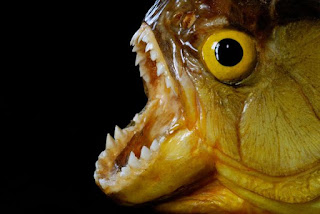1. Piranha
This fish is famous for its sharp teeth and appetite greedy, piranha inhabit some of the major river basins in South America. This omnivorous fish are also known for their taste for meat, although attacks on humans are rare enough, but we must remain cautious!
In fact Theodore Roosevelt saw that a bunch of piranhas tearing at the cow in a matter of seconds, is it myth of fact? beats me... :)
However, the piranha is a fish with an important role and predators in their native rivers, and they often do cannibalism if the food will be scarce. It is true that local fishermen sometimes have scars from the bite of the piranha fish.
There are many known species of piranha, with estimates ranging from 30 to 60 species. That's pretty dangerous animal isn't it??
In fact Theodore Roosevelt saw that a bunch of piranhas tearing at the cow in a matter of seconds, is it myth of fact? beats me... :)
However, the piranha is a fish with an important role and predators in their native rivers, and they often do cannibalism if the food will be scarce. It is true that local fishermen sometimes have scars from the bite of the piranha fish.
There are many known species of piranha, with estimates ranging from 30 to 60 species. That's pretty dangerous animal isn't it??
 |
| That's some scary Piranha's over there!! |
2. Anaconda
Hey, come on! have you seed anacondas movies??, you must be agreed that that's animal is some dangerous animal ever lived. Among the big snake in the world, including anaconda, live in rivers and wetlands of South America. Anaconda word probably derived from the Tamil word anaikolra, which means elephant killer, which means the reptiles scary and absolutely dangerous.Anaconda eating fish, birds, reptiles, and small mammals, as well as other animals. This large snakes can also harm people, although there are some facts that are very rare.
Like other predators, anacondas are nonvenomous, they often kill their prey by constricting it. Like other snakes, they swallow whole prey devouring until exhausted.
 |
| A very Big anaconda |
| Yummy.. too bad for you crocs! |
3. Candiru fish
Well this one is probably a species of freshwater fish the most dangerous of all that is here, why? because the fish is a parasitic catfish in Families Trichomycteridae. The Candiru usually takes big fish gills in the Amazon. However, during the past few centuries there have been reports of these creatures living in urethras men and women. Wow, that some dangerous dudes :P.Some natives along the Amazon have explained how to prevent infection disturbing, because if it had been said to be infected very difficult to heal, even with surgery was difficult. The act of protection is to wear thick clothes, don't let the candiru enters your body, and avoid urinating around the river. But sttill, prevention is the most important thing bro.
There are a very few cases of Candiru attacks on humans, one of it is the incident away from 1997 have been addressed. Candiru with an average width of a quarter inch long and an average of three inches, Candiru fish can be called a little large to fit into the urethra. However, the worst can still happen.
 |
| Cute little Candiru Fish |
 |
| Not so cute anymore! dooh :( |
4. Mata mata
Mata mata (Chelus fimbriatus) is a freshwater turtles that inhabit the Amazon and Orinoco in South America. This bizarre turtles in the waters, they live in shallow water / stagnant water, where they can easily make their heads out of the water to breathe.This species can grow quite large, up to 33 pounds (15 kilograms). They feed on invertebrates and fish that he is not dangerous to humans, but if you can eat animals, it certainly eat a human right? (yeah right! :) ).
Mata mata quite sensitive to water quality, both in captivity and in the wild, so they can feel if there is water pollution.
 |
| Cute and dangerous mata mata |
5. Diving Bell Spider
Diving Bell Spider (Argyroneta aquatica) is known as spiders that live just under the water. As with other arachnids, he must breathe air, but it could provide themselves with a form of air bubbles, which are placed in the hair on the legs and abdomen. These spiders sometimes have to go back to the surface to replenish their air supply, although sometimes gas exchange occurs across the surface of the bubble, so they do not have to keep on surface.
Diving Bell Spider found in northern and central Europe and parts of Asia to the north. Unlike spiders usually, this one spider men is larger than women, possibly because men are more active hunters.
This spider bite can cause painful and often accompanied by fever.
 |
| Hey, where's your bell spidey?? |
6. Electric Eel
Electra electric eel (Electrophorus electricus) indicates the strength of which surprised him at Ford Motor Company "Production Cycle" which is on display in 1939 at the New York World Fair. Despite their name electric eels, electric eel is actually kind knifefish and more closely associated with catfish. The electric eels hunt prey and defend themselves by producing a strong electric bursts.
Electric eels rise to the surface to breathe. Thanks to the special organs, they can generate more electrical pulses of 500 volts. It can be said to be enough to kill an adult human, so it is a dangerous animal!.
Electric eels hunt mostly invertebrates. They only attack humans if they feel disturbed. They tend to live in the murky water, or water that is stagnant. Scientists have long been fascinated by this species and have investigated the electrical capabilities are impressive.
 |
| Awh, its so soft, slimy and... it tickles.. |
























































